
These exercises work on your chest’s tense and tense muscles, encouraging relaxation and preventing the emergence of new problems.
Back And Chest Pain is becoming an increasingly widespread issue. There are several reasons why it occurs, but the main ones have to do with not exercising, adopting bad posture, and working for extended periods of time while seated.
Read More – Benefits Of Almonds For Women: Do Almonds Lower Blood Sugar And Diabetes?
If left untreated, severe back pain can cause a variety of problems. It may cause many types of pain and alter your posture permanently. You may find it difficult to walk, sit on a chair, lay in bed, bend over to get something, and other everyday activities if you have back pain. It’s treatable that these pains are, thankfully.
Read More – Summer Hair Care: Show Off Your Locks With These Insider Advices This Summer
Consult a physician to determine whether the discomfort is a result of an external source or a poor diet. Whatever the situation, exercise is the answer that Roland Liebscher-Bracht, the most reputable pain expert in Germany and the writer of multiple best-selling books on the subject, offers. Along with his spouse, Dr. Petra Bracht, Roland has created a ground-breaking technique for treating pain disorders using “osteo pressure,” which involves applying pressure to particular body spots, and customised stretching exercises. There is no need for medicine or surgery because the discomfort is completely stopped.
The Top Three Exercises For Back And Chest Pain Are Shown Below
First Exercise: Thoracic Spine Stretching
- Grab a foam roller. Placing your posterior on the ground, take a seat and position the foam roller behind your back.
- Place the foam roller under your thoracic spine and lie back on it.
- The thoracic spine and the nipples are situated at roughly the same level.
- Lengthen yourself as much as you can and extend your legs. Now your head and neck are on the ground.
- Verify that the foam roller is positioned correctly. You should experience some upper back ache if it is correct.
- Now, inhale deeply and consider if, according to your own pain scale, you have already attained level nine. If not, adjust your posture by slightly shifting your upper body back and forth. You may also need to realign the foam roller.
- For at least two minutes, if not more, hold your stretch. The key to this is to stretch the muscles in your back, which will help to relax your rounded back that results from shortened muscles in the front of your upper body. Your thoracic spine’s muscles will relax as a result of this floor workout.
Exercise 2: Chest Opening
- As far apart as your two arms can reach, position two seats.
- Bend your legs and take a kneeling position between the two chairs. Spread your arms wide on both sides. First, extend them horizontally, or at a roughly 90-degree angle, so that your palms are resting on the chair seats and facing down.
- Lean forward and raise your arms ten degrees or so above your head. It’s crucial that you bend forward at the same angle until your palms are back on the chair seats.
- As you inhale and exhale, maintain your posture. Try to bend a little bit lower the next time you exhale. At that point, a distinct strain discomfort in your chest should be felt.
- Inhale again, maintain the pose, and the next time you exhale, extend the stretch a little more.
- For almost two minutes, keep breathing in the same way with each additional breath. This exercise is going to help you stretch the region surrounding your pectoral muscles.
- An alternative is to perform the same exercise while standing if you don’t want to shift your upper body on the floor. Go to a corner of a room that is free and do it. Stretch your arms out in a horizontal position, press them up against the two walls that make up the corner, and continue pushing your upper body forward.
Exercise 3: Diaphragmatic Stretching
- Lie back in a chair.
- Take a deep breath in and out. Your upper body will involuntarily lean forward, as you will notice.
- Inhale deeply once again.
- Expel as much air as you can. Let your upper body sink forward voluntarily while maintaining support for it. Allow the descent to pull your entire body between your legs, expelling all the air from your lungs.
- After finishing this motion, squeeze your nose and seal your mouth.
- Return your body to an upright position on the seat while keeping your mouth and nose shut.
- Keep your mouth and nose shut. Until you feel as though your lungs are empty of oxygen, keep trying to breathe in. As you wait, gently rock back and forth.
- Aim for multiple completions.
- Your diaphragm rises into the chest cavity during exhalation and descends into the abdominal cavity during inhalation. A vacuum is produced when you attempt to breath while keeping your lips and nose shut. This causes your lungs’ remaining oxygen to be completely used up, which permits your diaphragm to enlarge even more. This exercise can help prevent the diaphragm from becoming too short.
After doing this, you’ll realise that your pain has subsided and that you can breathe much more easily.
“By focusing on your chest’s stiffness and muscle tension, these workouts help you relax and stop new problems from arising. You can prevent future discomfort in addition to treating current pain by including these workouts in your programme, the doctors advised.
Read More – Brainomix Achieves Breakthrough With FDA Clearance Of E-Lung AI Software


